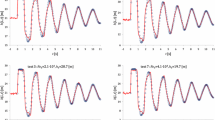Amathematical model is presented for two-phase flow in a pump station. The model is based on three-dimensional non-steady-state Reynolds equations. Turbulence is modeled using the standard k-ω SST model. Two-phase flow is calculated by the VOF method. Analyses of liquid behavior are presented under different initial liquid levels in the station. A optimum value for the initial liquid level is obtained. Areas of vortex formation are shown when the liquid level deviates from the recommended value. The effectiveness of the given pump station design is confirmed.
Similar content being viewed by others
References
S. Patankar, Numerical Heat Transfer and Fluid Flow, Hemisphere Publishing Corporation, New York (1980).
V. O. Lomakin and A. I. Petrov, “Verification of analysis results for the flow channel section of an AX-50-32-200 centrifugal pump using the STAR-CCM+ fluid dynamics modeling package,” Izv. VUZov, 2012, pp. 6 – 9.
V. O. Lomakin, A. I. Petrov, M. S. Kuleshova, “A study of twophase flow in an axial-centrifugal impeller using fluid-dynamics modeling methods,” Nauka Obrazov. Electronic J., No. 9, (2014). Accessed at: http://technomag.bmstu.ru/doc/725724.html (accessed on 09/23/2014).
C. E. Brennen, Fundamentals of Multiphase Flows, Cambridge Univ. Press, Cambridge (2005).
David C. Wilcox, Turbulence Modeling for CFD. 3rd Edition, DCW Industries (2006).
Zh. Daqing, Zh. Yuan, X. Ge, “CFD simulation of the whole pump station inlet flow field,” in: ASME 2008 Fluids Engineering Division Summer Meeting Collocated with the Heat Transfer, Energy Sustainability, and 3rd Energy Nanotechnology Conferences. Vol. 1. Symposia, DOI: 10.1115/FEDSM2008-55235.
H. Ding, F. C. Visser, Y. Jiang, and M. Furmanczyk, “Demonstration and validation of a 3D CFD simulation tool predicting pump performance and cavitation for industrial applications,” J. Fluids Eng., 133(1) (2011), DOI: 10.1115/1.4003196.
American National Standard for Pump Intake Design. ANSI/HI(2012).
H.W. Hua and M. Jermy, “Validated CFD simulations of vortex formation in jet engine test cells,” in: 16th Australian Fluid Mechanics Conference, (2007).
T. C. Kueh, Sh. L. Beh, D. Rilling, and Y. OOi, “Numerical analysis of water vortex formation for the water vortex power plant,” Int. J. Innov. Manag. Technol., 5(2) (2014).
Author information
Authors and Affiliations
Corresponding author
Additional information
Translated from Gidrotekhnicheskoe Stroitel’stvo, No. 8, August 2015, pp. 13 – 16.
Rights and permissions
About this article
Cite this article
Lomakin, V.O., Kuleshovav, M.S. & Bozh’eva, S.M. Numerical Modeling of Liquid Flow in a Pump Station. Power Technol Eng 49, 324–327 (2016). https://doi.org/10.1007/s10749-016-0623-9
Published:
Issue Date:
DOI: https://doi.org/10.1007/s10749-016-0623-9



